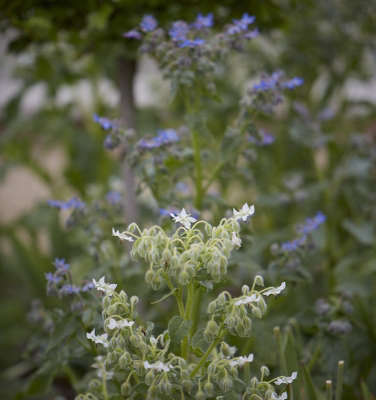

Native to Mediterranean climates, borage has since Homer's day been a prized medicinal and culinary herb; as a companion plant in an edible garden, it will ward off pests.
Borage comes by its nickname—starflower—honestly, with bright blue or white starbursts when it blooms. It will thrive in sunny spots with well-drained soil and if bees had to pick a favorite flower, this annual herb would win; its nectar proves irresistible to pollinators.
Don’t be misled by the fact that Borago officinalis is a true annual, which means its life cycle unfolds over the course of a single year. (An annual plant germinates, grows, flowers, and dies in the course of a growing season.) You can count on borage to self-sow in the garden; it will pop up next year in unexpected but delightful clumps. Borage is also delicious in salads, its leaves adding a flavor reminiscent of cucumber (borage flowers are sweet like honey—try them). Tip: Watch out for its hairy leaves, which can be prickly; wear gloves when you’re cutting back or pulling borage plants from the garden.
v5.0
When you register as a free Member of the Remodelista family of websites (Remodelista, Gardenista, and The Organized Home), you gain access to all current posts plus 10 archived posts per month, our internal bookmarking tool, and the community bulletin board.
Member benefits include:
For $5/month ($59.99 paid annually) you'll enjoy unlimited, ad-free access to Remodelista, Gardenista, and The Organized Home and all the benefits of Membership.
Subscriber benefits include:
For $5/month ($59.99 paid annually) you'll enjoy unlimited, ad-free access to Remodelista, Gardenista, and The Organized Home and all the benefits of Membership.
Subscriber benefits include:
Benefits include:
For $5/month ($59.99 paid annually) you'll enjoy unlimited, ad-free access to Remodelista, Gardenista, and The Organized Home and all the benefits of Membership.
Subscriber benefits include:
When you register as a free Member of the Remodelista family of websites (Remodelista, Gardenista, and The Organized Home), you gain access to all current posts plus 10 archived posts per month, our internal bookmarking tool, and the community bulletin board.
Member benefits include:
If at any time you want to become a Subscriber and enjoy unlimited, ad-free access to all our content, just go to the My Account link and choose Subscribe.
Advertising funds our work at Gardenista and helps us provide you with a daily dose of garden inspiration & design. We hope you’ll consider disabling your adblocker for Gardenista so we can continue our mission: a well-designed garden for all.
Thank you for your support.